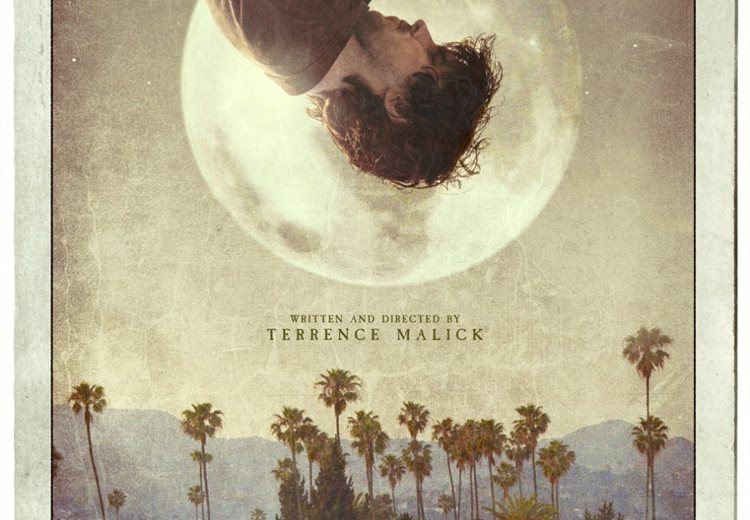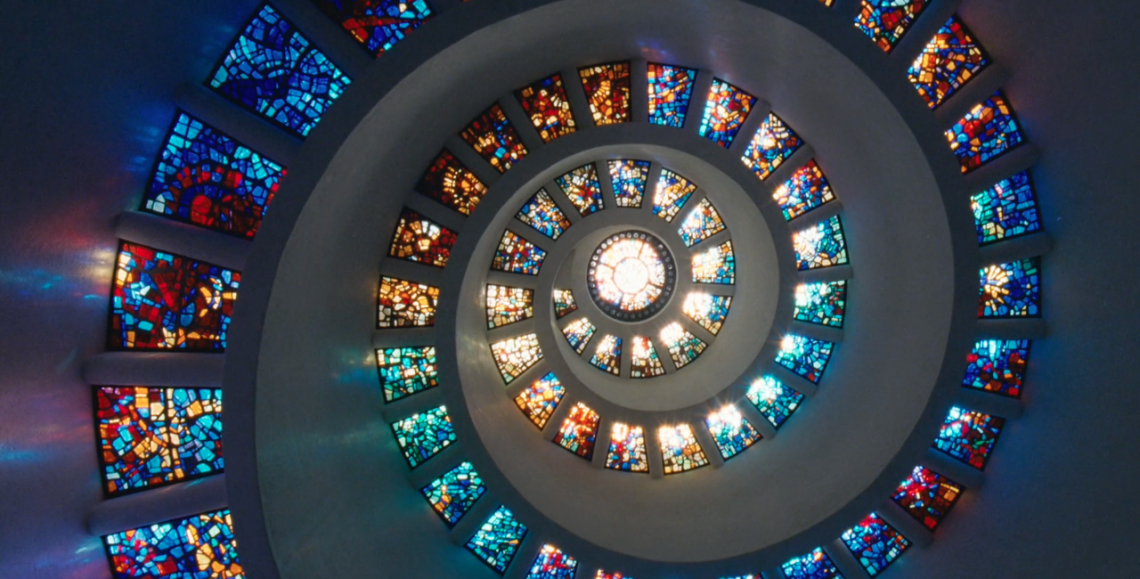
This post was written by Gilbert Colon.
A Vanity Fair headline commenting on the trailer for filmmaker Terrence Malick’s recent film Knight of Cups – starring Christian Bale as a lost soul screenwriter wandering the wasteland of hedonistic Hollywood – read “Existential Despair Is So, So Beautiful” (by Nick Romano, 11/25/15), as if Malick’s body of work was merely the empty aestheticization of suffering. Some commentators, perhaps parroting one another, went so far as to dismiss his films as feature-length perfume ads, but these detractors have entirely missed Malick’s point.
If Malick’s films are indeed existentialism, they are the existentialism of Søren Kierkegaard, not Jean-Paul Sartre and Albert Camus, and as a Christian philosopher, Kierkegaard did not traffic in despair. All of Malick’s desolation on display is, to borrow the words of Fr. Quintana (Javier Bardem) in To the Wonder, “perhaps…waiting to be transformed into something higher.” The suffering is not tragic hopelessness, but a sanctified stage in a pilgrim’s spiritual progress as he makes his way to beatitude. (Malick of late seems to have been filming, undetected, states of mystical theology as outlined by Christian masters such as PseudoDionysius, St. John Climacus, and Fr. Reginald GarrigouLagrange.)
The wounds of the human condition that Malick lays bare are the birth pangs of Romans 8: 18, 22-23:
For I consider that the sufferings of this present time are not worth comparing with the glory that is to be revealed to us … For we know that the whole creation has been groaning together in the pains of childbirth until now. And not only the creation, but we ourselves, who have the first fruits of the Spirit, groan inwardly as we wait eagerly for adoption as sons, the redemption of our bodies.
The labor pains offer hope to the “young prince” of Knight of Cups who, as Ben Kingsley narrates from “The Hymn of the Pearl,” drank from “a cup [and] forgot he was the son of a king, forgot about the pearl and fell into a deep sleep.”
Though Malick characters move “under the similitude of a dream,” their every waking hour remains pregnant with possibility, potential, and expectation, even if it does not always seem so on the watery surfaces from which spring life both old and new. The first step is to “Awake, O sleeper, and arise from the dead, and Christ will shine on you” (Eph. 5:14). Then and only then can the young prince count himself the “merchant man” of Matt. 13:45-46 “[w]ho…found one pearl of great price” and thereafter arrived at “the desired country.”
The misery Malick makes provision for only looks like “beautiful despair,” especially to the uninitiated. A priest in Knight of Cups, Fr. Zeitlinger (Armin MuellerStahl, who once played Joseph in the 1999 TV movie Jesus), frames this anguish in a brief but crucial scene that almost directly challenges Vanity Fair’s premises:
“He shows His love not by helping you avoid suffering, but by sending you suffering, by keeping you there. To suffer binds you to something higher than yourself, higher than your own will. Takes you from the world, to find what lies beyond it. We are not only to endure patiently the troubles He sends, we are to regard them as gifts. As gifts more precious than the happiness we wish for ourselves.”
This is the agony before the ecstasy, the darkness before the dawn, the cross before the resurrection…
Malick is trying to film a beatific vision for which there is no visual vocabulary. He has been building one from scratch for the past four decades (first in Badlands and Days of Heaven, then in The Thin Red Line and The New World) and, in his old age, he has hastened his efforts (The Tree of Life, To the Wonder, Knight of Cups, and the upcoming Voyage of Time, back-to-back films in a span of four years).
Not entirely from scratch – Malick artfully draws from Scripture with great frequency, using oblique imagery and making allusions that often go undiscerned by post-Christian audiences who, eyes still coated with scales, see the blinding light of his transfiguring cinema through a lens darkly. To accomplish this vision, Malick eschews digital effects fakery and largely draws upon the beauty of the created natural world which foreshadows the world which is to come (literally seen as a “sweet by and by” on a “beautiful shore” at the end of The Tree of Life).
When he does resort to special effects, as he does in The Tree of Life, he utilizes the talents of award-winning visual effects legend Douglas Trumbull (2001: A Space Odyssey) to envision the Big Bang and Age of Dinosaurs in the most scientific manner, asserting onscreen the metaphysical through the physical. This October, Malick will bring this trademark “transcendental style” to bear with the realization of his three decade long ambition, an epic documentary chronicling the beginning and end of the cosmos (only glimpsed at in The Tree of Life) titled The Voyage of Time. The Tree of Life’s visual effects supervisor Dan Glass (Batman Begins and The Matrix sequels) will spectacularly provide “[t]he heavens [that] declare the glory of God” (Psalm 19:1).
Consistently, Malick has tried to convey very mystical but academic concepts in the language of motion pictures which is largely the language of emotion. Vanity Fair dismissed Knight of Cups’ “vibrant colors, and shimmering lights” as “a wild—or at least beautiful—ride,” but light has always been an essential Malick motif. Characters in The Thin Red Line speak of “the beautiful light,” “the glory,” and “all things shining.” This luminosity is captured by his cinematographer Emmanuel Lubezki, who previously worked with Malick on The New World, The Tree of Life, and To the Wonder, and recently won an Oscar for his work in Alejandro G. Iñárritu’s The Revenant.
Author Paul Maher Jr., in his book One Big Soul: An Oral History of Terrence Malick, excerpts early script notes dating from 1979 for what would become The Tree of Life. In those sketches, Malick states his intentions: “Everything seems like an emanation, a mere ray, of the First Light, deriving vigor and glory from this first source…we should feel part of all this glory.” The lens flares and golden hours – “God’s best light,” Malick calls it – are not there merely to prettify the picture, but to capture and convey those rays from this First Light, which in Malick’s cinematic universe is God, the Uncreated Beauty.
Twice in The Tree of Life, stained-glass catches this wonder, once in a shot of the “Glory Window” of Dallas’ spiraled Chapel of Thanksgiving, then in a church window depicting Christ awaiting Crucifixion. In that film, Mrs. O’Brien (Jessica Chastain) exhorts, “Love everyone…every ray of light.” Why love every light? As Joseph (Brian Dennehy) counsels his son in Knight of Cups, “Find the light…in the eyes of others.” As Fr. Quintana (Javier Bardem) prays, “Flood our souls with Your spirit and life…so completely that our lives may only be a reflection of Yours. Shine through us.”
Music too is the language of emotion, so Malick abundantly accompanies his visuals with explicitly Christian compositions – Hector Berlioz’s Grande Messe des Morts in The Tree of Life, Johann Sebastian Bach’s “To Us A Child Is Given” in To the Wonder, Arvo Pärt’s Miserere from Knight of Cups, and in The Voyage of Time the “Resurrection” Symphony from Gustav Mahler and Bach’s Mass in B Minor – letting the notes and chords speak where words or special effects might fail. The classical selections, which number in the hundreds, together comprise a “Symphony of Sorrowful Songs,” to borrow the title of a Henryk Górecki piece (in fact used to score Fr. Quintana’s spiritual regeneration in To the Wonder).
The significance of this sacred music often goes unnoticed to the secularized viewer who hears it as concert music divorced from its religious origins, and sees it as music montage or music video. As with the “despair,” this music is not purely aesthetic, but exists within a concrete context – a Christmas cantata and a Mass in the case of Bach, a Requiem with Berlioz, and a setting of Psalm 51 from Pärt.
And also, in the case of Knight of Cups, Ralph Vaughan Williams’ opera “The Pilgrim’s Progress,” supplemented by the text of John Bunyan’s epic allegory recited by the late Sir John Gielgud. Recitations of Psalm 104 and Plato’s The Phaedrus by Charles Laughton also waft through the air as commentary on the fragmentary action, mingling with interior monologues. Gielgud and Laughton serve as disembodied voices from the beyond, an off-stage Greek chorus offering poetic punctuation and, like the sacred choral compositions, textual gloss underscoring the Holy. Still it falls on deaf ears that only hear wispy poetry and not something more.
There is an ancient Greek word for this “love of beauty,” or more precisely “love for God as the source of all things beautiful,” used by the ancient Church Fathers – philokalia. It is that same “beauty of holiness” spoken of by the Psalmist (Ps. 29:2 and 96:9). To Malick, “So, So Beautiful” is not a matter of beautifying “Existential Despair,” but of something written by one of his favorite authors, Fyodor Dostoyevsky, in his Notebooks for The Possessed: “The Holy Spirit is the direct seizure, the grasping of Beauty.”
Not just any beauty, but a very specific beatific beauty.
KNIGHT OF CUPS was released theatrically in March and on Blu-ray and DVD in June. Malick’s documentary passion project, THE VOYAGE OF TIME, screens in IMAX theaters beginning October 7th.

COMMENTS
2 responses to “The Beatific Vision of Knight of Cups Director Terrence Malick”
Leave a Reply

















Kierkegaard did not traffic in despair?
https://www.reddit.com/r/philosophy/comments/3c2dg9/a_critical_commentary_on_the_school_of_lifes/
“Gloomy” and “anxiety-ridden” tend to emphasize the picture of Kierkegaard as the “melancholy Dane.” Simon Podmore [author of Struggling with God: Kierkegaard and the Temptation of Spiritual Trial] helpfully explains that “this oft-repeated legend for Kierkegaard—‘the melancholy Dane’—represents a perception that only sees half the face, as it were, of one of modern theology and philosophy’s most insightful exponents of the triumph of faith over despair” (Kierkegaard and the Self Before God, p. xi). We see this in Kierkegaard’s journal and notebook entries on joy, and in his treatment of joy in Christian Discourses.